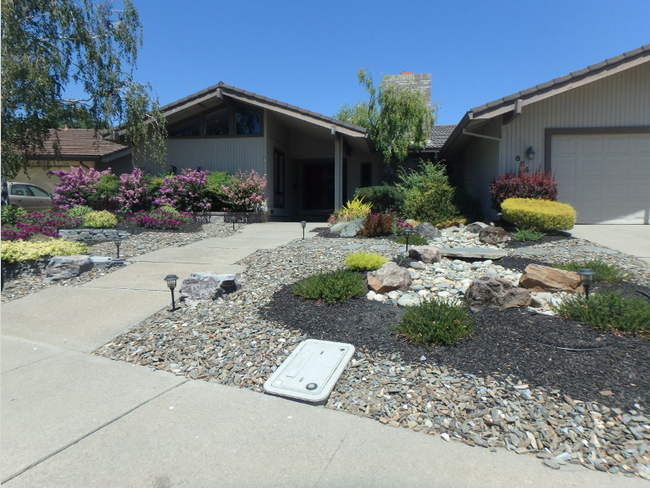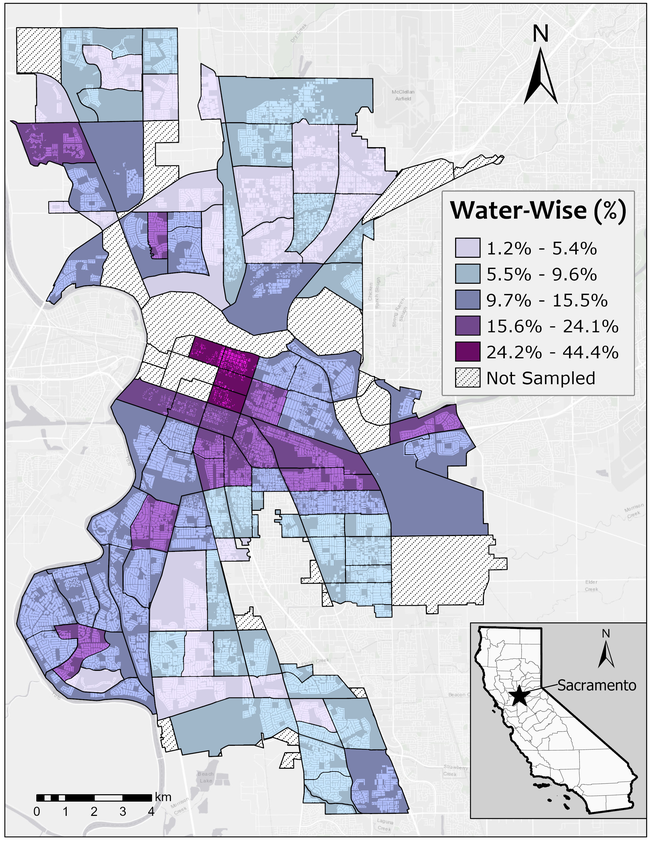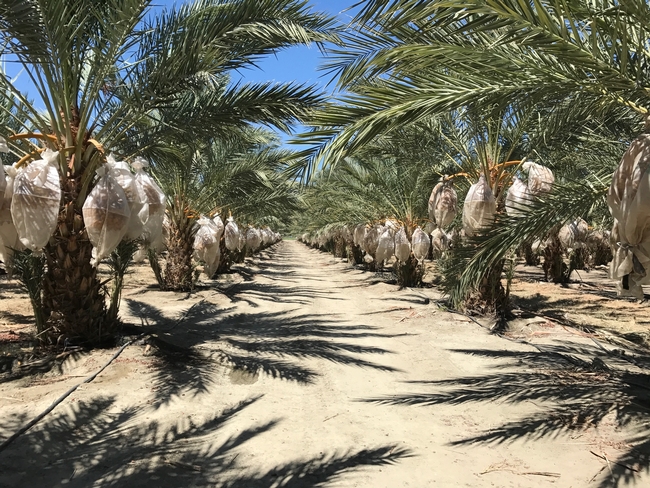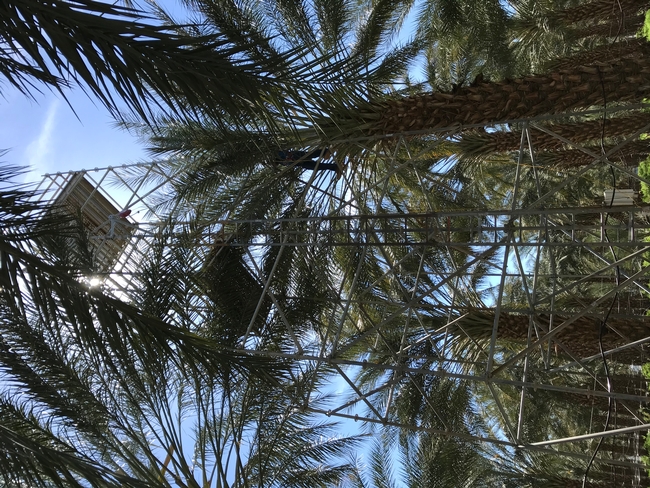
Posts Tagged: conservation
Patterns and drivers of water-wise landscaping for urban water conservation
Front yard with water-wise landscaping. Photo Credit: Cadenasso Lab, UC Davis
California's urban water agencies have long relied on conservation measures to promote reliability and manage costs. Since landscapes are a large portion of water demand in California cities, many water agencies encourage water conservation by incentivizing the replacement of water-intensive turf lawns with water-efficient or “water-wise” landscaping.
In California's Mediterranean climate, traditional turfgrass lawns require irrigation to maintain their appearance through the hot summer months. Inefficient, poorly managed spray irrigation systems can also result in considerable water loss from runoff and evaporation. Replacing turf and overhead sprinklers with low-water-use plants, alternative ground covers like mulch and kurapia, and more efficient drip irrigation systems can potentially save hundreds of gallons of water per square meter every year.
Although the water savings from turf replacement can be substantial, generating widespread buy-in is a challenge. Landscape renovation can be expensive and intimidating, requiring residents to learn new landscape management practices or pay for professional assistance. In addition, many people appreciate their lawns as spaces for children, pets, or entertainment. Some prefer the look of turfgrass, especially where neighborhood norms promote a unified lawn aesthetic.
To help overcome cost barriers and encourage water-wise landscaping, government agencies and water suppliers commonly offer “cash for grass” programs, in which residents are offered a rebate for landscaping expenses based on the amount of turf they replace. These programs also aim to promote neighborhood adoption of water-wise landscaping by providing attractive examples. Turf replacement incentive programs are likely to expand under proposed new water use efficiency regulations, Making Conservation a California Way of Life (AB1668 - SB606).
While large-scale, regional turf replacement programs in Southern California have been evaluated in peer-reviewed studies, questions remain about the extent and impact of these programs in other parts of the state. How widely are turf replacement programs utilized, and by whom? Are these programs responsible for a substantial amount of water-wise landscaping?
Water-wise landscaping in Sacramento
With these questions in mind, we wanted to understand how both rebate recipients and houses with independently installed water-wise landscaping were distributed across an entire city in inland Northern California. The study was recently published in the Journal of Urban Ecology.
We visually surveyed the front yards of all single-family homes in 100 census tracts across the city of Sacramento—109,062 homes in total—and compared the prevalence of water-wise landscaping with the city's turf replacement rebate data. We especially wanted to understand how this landscape water conservation measure was being adopted by communities of varying socioeconomic and demographic characteristics, and which communities were benefitting from the rebate program.
Front yard with traditional turf. Photo Credit: Cadenasso Lab, UC Davis
In Sacramento, the City's Department of Utilities has offered a rebate of (typically) $1.50 per square foot of turf removed since the summer of 2014. To qualify for the rebate, replacement landscapes must meet several criteria, including efficient irrigation systems and approved plants that cover more than half of the area at maturity. The planting requirement addresses an important concern with turf replacement—the potential for an increase in urban heat. Lawns have a cooling effect through evapotranspiration, and if they are replaced primarily with non-living groundcovers, temperatures could increase. However, such program requirements can make some residents reluctant to participate.
When we conducted our visual survey of front yards in 2018, we found that approximately 10% of Sacramento's single-family-homes had water-wise yards, while 88% had conventional lawns. Only around 3% of water-wise yards were rebate recipients, though, meaning that the vast majority—97%—of water-wise yards were landscaped independently from the city's rebate program. We also found support for neighborhood adoption effects, with clustering of water-wise yards at the city block scale.
The prevalence of independent water-wise yards should be good news for water conservation, since it would not be feasible for the city to fund many thousands of turf replacement projects. However, independent turf replacement projects don't need to comply with the city's requirements for plant coverage or irrigation system efficiency, meaning that they could be contributing to increased urban temperatures or failing to save water.
Our study also showed that water-wise landscaping was more common in census tracts with less diverse, more highly educated, and more affluent populations, as well as fewer households with children. Rebate recipients followed the same trends, suggesting that rebates weren't overcoming barriers to adoption. The uneven distribution of resources necessary for turf replacement—money, time, and information—is likely an important driver of this pattern, along with cultural or functional preferences for lawns. Lawns may play a particularly important role for families as spaces for children to play.
Photo Credit: Cadenasso Lab, UC Davis
A Tool in the Toolbox
Turf replacement is one important tool in the water conservation toolbox, and our research suggests that many residents voluntarily install water-wise landscapes even without a rebate. However, adoption is not equal across communities. The roots of this disparity likely reflect uneven distributions of resources and preferences.
With thoughtful program design and outreach, incentive programs could help overcome some of these barriers, although funding and staffing limitations in water agencies pose a challenge for implementation. For instance, carefully crafted direct installation programs could reach lower-income residents who find it difficult to pay up-front costs associated with rebates. Tailoring efforts to the needs of lower-income and marginalized communities will be important to ensure that they do not end up with unirrigated, high-heat landscapes instead of attractive, water-wise yards.
In the Sacramento region, focus groups conducted for the Regional Water Authority revealed that some residents have a very strong preference for lawns. In these cases, water suppliers may have greater impact by promoting efficient irrigation practices, turfgrass varieties that use less water, and climate-appropriate shade trees. Partial lawn conversions are also a viable water-saving strategy, and one that Sacramento's rebate program supports.
As California's cities grapple with climate change, water reliability, cost effectiveness, and meeting new water use efficiency standards, reducing high-water-use turf lawns will continue to be an important adaptation strategy. Figuring out how to support effective and equitable landscape water conservation programs must be a focus of future research and evaluation studies to promote a California where everyone benefits from climate adaptation measures.
Joanna Solins is an Environmental Horticulture Advisor with UC Cooperative Extension, serving Sacramento, Solano, and Yolo Counties, and is an Affiliate Researcher with the California Institute for Water Resources and the UC Davis Department of Plant Sciences.
Acknowledgments: Many thanks to Erik Porse, Amy Talbot, Jasmin Green, and Mary Cadenasso for their input and assistance with this post.
Additional Reading
Green, J. C., Solins, J. P., Brissette, L. E. G., Benning, T. L., Gould, K., Bell, E. M., & Cadenasso, M. L. (2024). Patterns of water-wise residential landscaping in a drought-prone city. Journal of Urban Ecology, 10(1), juae003. https://doi.org/10.1093/jue/juae003
Alliance for Water Efficiency. (2019). Landscape transformation: Assessment of water utility programs and market readiness evaluation. https://www.allianceforwaterefficiency.org/impact/our-work/landscape-transformation-assessment-water-utility-programs-and-market-readiness
Matlock, M., Whipple, R., & Shaw, R. (2019). Just for the turf of it: Turf replacement as a water conservation tool. Journal of Soil and Water Conservation, 74(5), 449–455. https://doi.org/10.2489/jswc.74.5.449
Pincetl, S., Gillespie, T. W., Pataki, D. E., Porse, E., Jia, S., Kidera, E., Nobles, N., Rodriguez, J., & Choi, D. (2019). Evaluating the effects of turf-replacement programs in Los Angeles. Landscape and Urban Planning, 185, 210–221. https://doi.org/10.1016/j.landurbplan.2019.01.011
Simpson, S.-A., Altschuld, C., Ortiz, A., & Aravena, M. (2023). Green to gold mile: An environmental justice analysis of drought and mitigation policy impacts on home landscapes in Sacramento California. Landscape and Urban Planning, 234, 104729. https://doi.org/10.1016/j.landurbplan.2023.104729
Survey request re on-farm wildflower strips and conservation measures
A colleague and a graduate student at Cornell University are conducting a survey to assess grower...
Art Shapiro: Sharing Information on Monarch Butterflies
UC Davis distinguished professor emeritus Art Shapiro, who's been monitoring the butterfly...

UC Davis distinguished professor emeritus Art Shapiro explains some of his research documentation at the Bohart Museum of Entomology open house on monarchs. (Photo by Kathy Keatley Garvey)
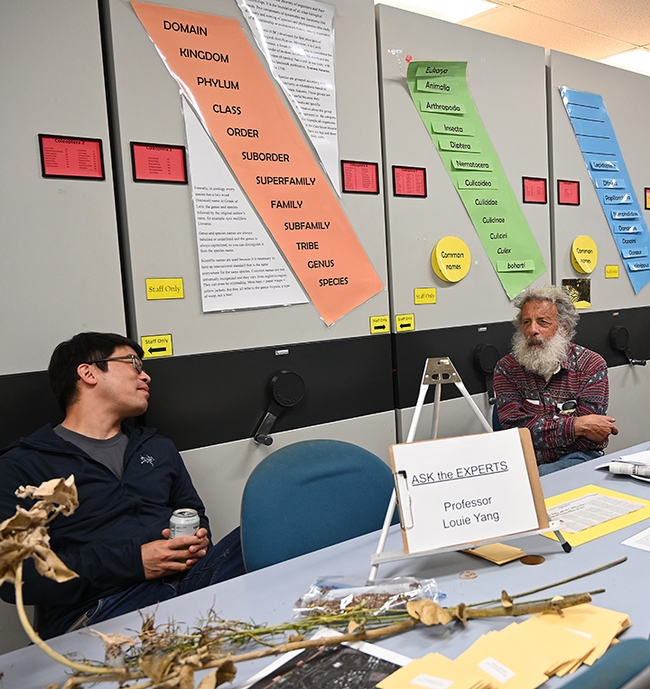
Professor Louie Yang (left) of the UC Davis Department of Entomology and Nematology, chats with UC Davis distinguished professor emeritus Art Shapiro of the Department of Evolution and Ecology during the Bohart Museum's open house on monarchs. (Photo by Kathy Keatley Garvey)
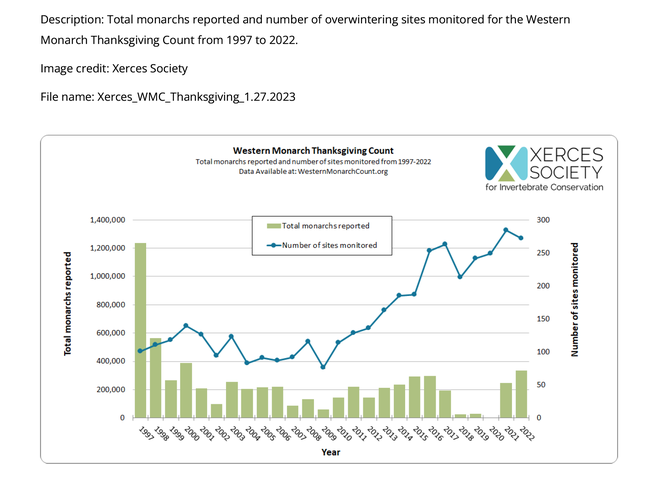
This document provided by Xerces Society of Invertebrate Conservation shows the number of monarchs overwintering along the California coast since 1997. Source: its annual Thanksgiving season count.
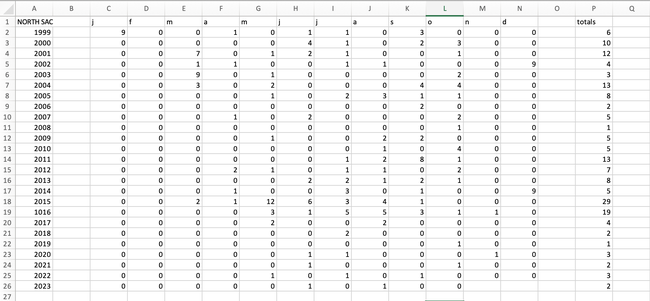
These are the monarch sightings that UC Davis distinguished professor Art Shapiro has recorded in his North and West Sacramento monitoring sites since 1999.
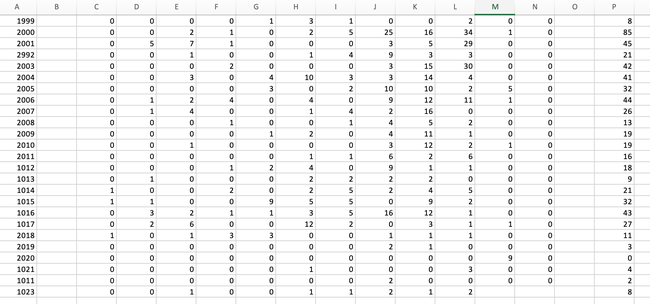
These are the monarch sightings that UC Davis distinguished professor Art Shapiro has recorded in his Rancho Cordova and Suisun monitoring sites since 1999.
UC Davis Professor Louie Yang: On Conserving the Western Monarch Population
"Recent studies have continued to shed light on the ecology of monarch butterflies (Danaus...
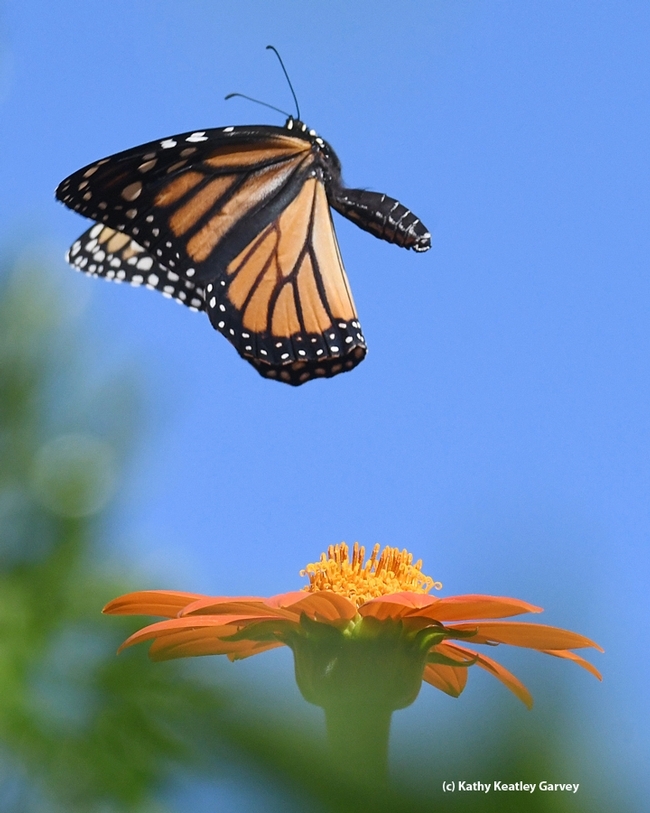
A monarch leaving a Mexican sunflower, Tithonia rotundifola. This image was taken in a pollinator garden in Vacaville. (Photo by Kathy Keatley Garvey)
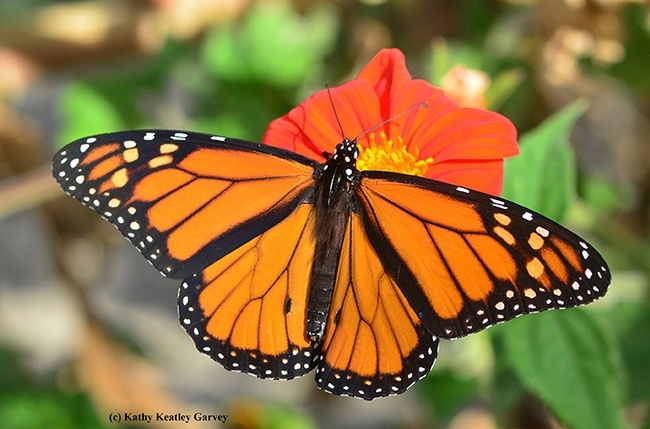
A male monarch nectaring on a Mexican sunflower, Tithonia rotundifola, in Vacaville. (Photo by Kathy Keatley Garvey)
Date palm irrigation research provides economic, environmental benefits
Historically, date palms are grown along riverbeds or in areas with groundwater because they require an abundance of water to produce a good crop. Unlike lettuce or table grapes, date palms are deceptive in that they do not immediately wilt if underwatered. Eventually, however, the lack of water hurts yields and fruit quality.
The default for date growers is to apply excessive water, but doing so is neither economically nor environmentally sound. To help growers, Ali Montazar, UC Cooperative Extension irrigation and water management advisor for Imperial, Riverside and San Diego counties, has developed knowledge that enables growers in the region to establish irrigation guidelines they can use with confidence.
“Water issues in California's desert are very different than in the Central Valley,” said Montazar. “There is no groundwater to recharge so growers in the desert only have the Colorado River.”
Since 2019, Montazar has been focused on irrigation management for date palms in the Coachella Valley, the largest producer of dates in the United States. Montazar's research identifies how much water is needed for the crop and the best water delivery method according to location, soil type and conditions, and date cultivars.
“Dates require a lot of heat and light, which is why they do well in the desert. But they also need a fair amount of irrigation,” said Robert Krueger, a U.S. Department of Agriculture horticulturist and Montazar's co-author of a paper on date palm irrigation management.
Much of what we know about date palm production comes from the Middle East, which has a climate similar to the low desert of California. “That information is from many, many years ago though,” explained Montazar, whose research shows that drip irrigation cannot be the only form of irrigation for date palms.
“Ali is the first to really look at micro-sprinklers and flood irrigation for date palms,” said Krueger, adding that the other advantage of Montazar's research is that it prepares growers for production during times of reduced water supply.
Albert Keck, president of Hadley Date Gardens, Inc. and chairman of the California Date Commission, described Montazar's research efforts as “subtle yet incredible and profound,” adding that his findings not only benefit other farmers but also cities relying on water from the Colorado River.
Keck, one of the largest date growers in California, is well aware of how disruptive, expensive and time-consuming irrigation for date palms can be. Montazar has enabled growers like Keck to irrigate less without sacrificing yield or quality.
“Ali might save us a tiny percentage of the amount of water we're using. It might be a 5 or 10% savings. It doesn't seem like much, but it's an incremental improvement in efficiency,” said Keck. “And if you add all of these improvements up, say, along the U.S. Southwest, then that has a pretty profound impact.”
Montazar recommends that date growers in his region use a combination of drip and two to three flood irrigation events to manage salinity levels derived from the Colorado River. “We cannot maintain salinity issues over time if we're only relying on drip irrigation in date palms,” explained Montazar.
Flood irrigation pushes the salts below the root zone, when they would otherwise build up within the root zone preventing efficient water uptake. It also aids in refilling soil profiles quickly and more effectively since drip has a lower capacity of delivering sufficient water.
“Growers know what they need to water their crop within a broader parameter. But Ali has narrowed that window and helped us become more precise with our irrigation,” Keck said. “There's still room for improvement but we're spending less money, wasting less time and using less water now, and we're still getting the same positive results.”
Currently,Montazar is collaborating with the California Date Commission on developing guidelines for best irrigation management practices in the desert for date palms, which should be available by the end of 2023. These guidelines are based on a four-year data set from six monitoring stations and extensive soil and plant samples from commercial fields located in theCoachella Valley, Imperial Valley and near Yuma, Arizona. Additionally, Montazar is working to quantify how water conservation impacts growers economically.
“Growers from United Arab Emirates, Egypt, Tunisia and Mexico have already reached out asking for this information,” Montazar said, while reflecting on a presentation he made to a group of international date growers in Mexico late last year.
To read the paper on date palm irrigation, published in MDPI's Water journal, visit: https://www.mdpi.com/2073-4441/12/8/2253.

